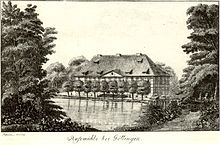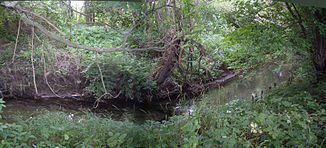Lawn (leash)
| Rush | ||
|
The lawn a few 100 meters from where it joins the line |
||
| Data | ||
| Water code | DE : 488172 | |
| location |
Lower Saxony district of Göttingen Rosdorf |
|
| River system | Weser | |
| Drain over | Leine → Aller → Weser → North Sea | |
| source |
Rasespring in the Tiefenbrunn settlement of Mengershausen 51 ° 29 ′ 57 ″ N , 9 ° 52 ′ 16 ″ E |
|
| Source height | approx. 185 m above sea level NN | |
| muzzle | from the left and west into the Leine near Rosdorf Coordinates: 51 ° 30 ′ 29 ″ N , 9 ° 55 ′ 13 ″ E 51 ° 30 ′ 29 ″ N , 9 ° 55 ′ 13 ″ E |
|
| Mouth height | below 155 m above sea level NN | |
| Height difference | approx. 30 m | |
| Bottom slope | approx. 7.5 ‰ | |
| length | 4 km | |
| Left tributaries | Grundbach | |
| Communities | Rosdorf | |
The Rase is an approximately 4 km long, left and western tributary of the Leine in the municipality of Rosdorf in the district of Göttingen in Lower Saxony . The stream rises from the Rasespring karst spring in the Mengershausen district , flows through Rosdorf and flows into the Leine on the left a few 100 m east of it.
geography
origin
The spring area called Rasespring is located in the Mengershausen settlement of Tiefenbrunn at the Asklepios specialist clinic Tiefenbrunn von Mengershausen and includes several springs that are spread over the place, sometimes heavily pouring and up to about 185 m above sea level. NHN were captured in artificially created ponds. One of the springs with dimensions of 20 × 10 m lies at the bottom of a reservoir built in the 18th century. The bottom of this spring funnel is 4–5 meters below the surface of the pond.
The Rasespring is one of the large karst springs that meet at the western edge of the Leine valley trench. Fractures in karst Upper shell cause the water on the layers of the tertiary sunk to the main fault Keupers dams and flows out at the Rasequelle in the bottom of the slope. The spring has a catchment area of 27 km², the annual groundwater recharge in this area is 4 million m³.
In 1978 and 1980 two deep wells were built above the spring to provide drinking water for Rosdorf and Klein Schneen . Between 1966 and 1985 the average flow rate from the spring including the flow from the wells was about 0.3 m³ / s.
course
From the Rasespring, the Rase flows eastward through Tiefenbrunn to the edge of the A 7 , where a brook flows from the south, which is longer with its upper course as a ditch next to field paths. A few hundred meters after crossing under the motorway, the run, accompanied by trees and bushes, swings north for less than a kilometer just before the L 573 Mengershausen – Rosdorf, then runs east again and towards Rosdorf, whose settlement area is then mostly open Run through. Close to the L 573 in the village, it flows together at a right angle with its noticeably longer tributary Grundbach and then continues in its inflow direction. On an easterly course, it leaves it again below in a tree gallery and soon afterwards flows from the left to over 150 m above sea level. NHN on the leash .
Tributaries
- Grabenlauf, from the right and south of Mengershausen. Arises as a field path ditch northwest of Mengershausen up to 220 m above sea level. NHN
- Grundbach / Grundbeeke , from left and west in Rosdorf. Rises east of Bördel as Bördelbach and is sometimes also called Beeke and Luhbach / Lohbeeke .
nature
The Rasequelle "Unter den Linden" was a natural monument in Rosdorf designated by the district of Göttingen and had the ND number 046. The status as a natural monument was revoked on the grounds that it was not a natural creation. The ponds are artificial and the stream developed.
etymology
The defining word of the place Rosdorf and the brook Rase have the same origin. The first written mention of Rosdorf as a Rasthorp is from the year 1004. The front vowel alternates between -a- and -o- in the mentions, with -o- predominating since the 12th century and also occurring in the river name. At the end of the 17th century, the river name changes to the current form Rase.
The leading determining element of both compound names ultimately goes back, like today's German word Rohr , to the Germanic root * rauza of the meaning '(reed) pipe', which lives on in a similar phonetic state in the French word roseau with the same meaning . The following basic word for the brook was probably the Old High German word aha for 'water, flood, river', which, for example , lives on in the numerous German water names Ache (n) and the water body name extension -ach less reduced than here. The meaning of the reed stream, reed water, arises for the name of the water.
history

In the late Middle Ages, the so-called Rasemühle, which belonged to the Hilwartshausen monastery in the 15th century, stood on the Rasespring. Apparently the karst spring poured enough for a profitable mill operation. From 1824 to 1903 the building then served as an excursion restaurant with a beer garden, which was frequented in particular by Göttingen students and where , according to Heine's Harzreise , apparently also crammed: " [List of fraternity members] ... those still in Göttingen today, hordes of and divorced by colors Hats and pipe tortures, walk along Weenderstraße, wrestle with each other forever on the bloody voting sites of the lawn mill, the Ritschenkrug and the Bovden ... " . Century found.
Picture gallery
Web links
- Wiki-Göttingen: Rasequelle (Rosdorf) (Version December 2, 2009)
- Galerie Göttinger Land: "Rasequelle in Tiefenbrunn" (August 29, 2014)
Individual evidence
- ↑ a b After the page about Rasequellen on the tourism project site www.goettingerland.de of the district of Göttingen.
- ^ Friedrich Kluge, Elmar Seebold: Etymological dictionary of the German language . 22nd edition. De Gruyter , Berlin, New York 1989, ISBN 3-11-006800-1 , pp. 604 (entry pipe ).
- ^ Center national des ressources textuelles et lexicales. Retrieved August 28, 2014 (etymology section of entry roseau ).
- ^ Friedrich Kluge, Elmar Seebold: Etymological dictionary of the German language . 22nd edition. De Gruyter , Berlin, New York 1989, ISBN 3-11-006800-1 , pp. 47 (entry Au (e) ).
- ^ Heinrich Heine: The Harz journey . Philipp Reclam jun., Leipzig 2008, p. 5 f . (at gutenberg.org ).






